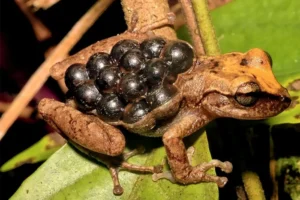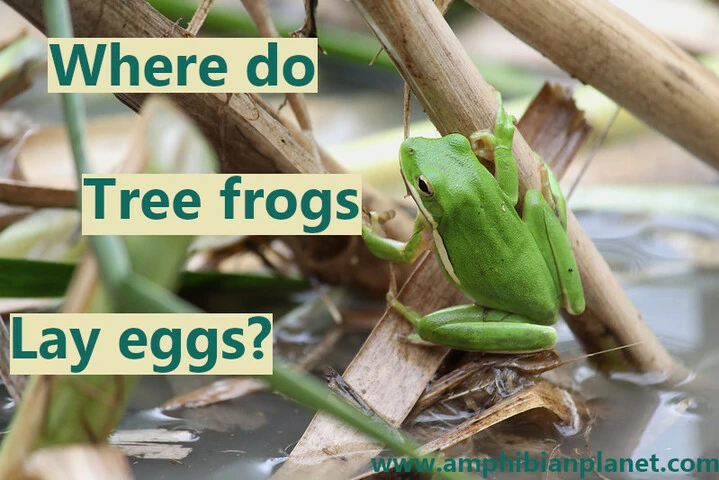Most frogs, including tree frogs, reproduce by laying eggs. Frogs that spend most of their time on the land will typically lay their eggs in shallow water bodies on the ground. But where do tree frogs lay their eggs?
Most tree frogs lay their eggs in shallow, fish-free freshwater bodies and attach them to submerged vegetation near the water’s surface. Some such as the red-eyed tree frog lay their eggs on plants hanging over ponds – when the tadpoles hatch they will drop into the water below.
Other tree frog species such as the gray foam-nest tree frog of southern Africa and the Fourlined tree frog of Southeast Asia lay their eggs in a foam “nest”.
This nest is built on branches or leaves overhanging a pond. When the tadpoles hatch, they will wriggle down the foamy secretion and plop into the water below.
A few tree frog species such as the common coquí away lay their eggs away from water. This could be in tree holes, the petioles of rolled palms, and even in abandoned bird nests.
Most Tree Frogs Lay Their Eggs in Water Bodies on the Ground
The majority of tree frogs lay their eggs in shallow, standing, or slow-moving freshwater bodies that are free of predatory fish. This could be in fish-free ponds, spring-fed pools, flooded ditches, lake edges, river backwaters, bogs, marshes, swamps, and even in deep tire tracks or potholes.
Some tree frog species such as the American green tree frog occasionally lay their eggs in water bodies with fish.
A few species such as the Phantom tree frog found in Guatemala – are even known to lay their eggs in fast-flowing streams, where they attach the eggs to the substrate.
Since these tree frogs lay their eggs in fast-flowing water, their tadpoles have very strong tails for swimming and mouths on the underside of their bodies. They use their large sucker-like mouth parts to cling onto rocks so they do not get washed away.
However, most tree frogs that lay eggs in the water will their eggs in stagnant, temporary water bodies that form after heavy spring, or summer rain. This could be in ponds, roadside ditches, or even deep tire tracks that fill with water.
Many tree frog species, including the spring peeper and the pacific tree frog, prefer to breed in something called “vernal pools“.
Vernal pools are temporal pools of water that form in the spring. They are formed when depressions on the ground are filled with water from melting snow and falling rain.

They are typically small and shallow, and unlike a pond or lake, they have no permanent source of water. This means they dry up in the summer.
Since they are temporal, they do not have fish that could eat the eggs before they hatch. This makes them ideal breeding sites for many amphibians.
Some tree frogs such as cricket frogs also lay their eggs in river backwaters and marshes – others such as the Sirerran trees frog are even known to lay their eggs in lake edges and reservoirs.
Below Is a Table That Shows the Type of Water Bodies Where 24 Tree Frog Species Will Lay Their Eggs In:
Tree Frog Species |
Scientific Name |
Where They Lay Their Eggs |
| Gray tree frog | Hyla versicolor | Ponds, vernal pools, swamps, and other wetlands |
| Cope’s gray tree frog | Hyla chrysoscelis | Ponds, vernal pools, swamps, and other wetlands |
| Green tree frog | Hyla cinerea | Ponds, vernal pools, marshes, and other wetlands |
| Spring peeper | Pseudacris crucifer | Pond edges, vernal pools, swamps, marshes, and other wetlands |
| American green tree frog | Hyla cinerea | Ponds, vernal pools, marshes, and other wetlands |
| Cuban tree frog | Osteopilus septentrionalis | Ponds, vernal pools, flooded ditches, swamps, and other wetlands |
| Pacific tree frog | Pseudacris regilla | Ponds, vernal pools, slow-flowing springs, lake edges, and other wetlands |
| Common Mexican tree frog | Smilisca baudinii | Ponds, vernal pools, slow-moving streams, and other wetlands |
| Pine woods tree frog | Hyla femoralis | Ponds, vernal pools, swamps, and other wetlands |
| Barking tree frog | Hyla gratiosa | Ponds, vernal pools, marshes, lake edges, and other wetlands |
| Squirrel tree frog | Hyla squirella | Ponds, vernal pools, marshes, and other wetlands |
| Australian green tree frog | Litoria caerulea | Ponds, vernal pools, swamps, and other wetlands |
| European tree frog | Hyla arborea | Ponds, vernal pools, lake edges, swamps, and other wetlands |
| Blanchard’s cricket frog | Acris blanchardi | Ponds, vernal pools, river backwater, and other wetlands |
| Southern cricket Frog | Acris gryllus | Ponds, vernal pools, bogs, swamps, and other wetlands |
| Northern cricket frog | Acris crepitans | Ponds, vernal pools, lake edges, slow-moving streams, river backwaters, and other wetlands |
| Pine Barrens tree frog | Dryophytes andersonii | Ponds, vernal pools, bogs adjacent to pine forests, and other wetlands |
| Sierran tree frog | Pseudacris sierra | Ponds, vernal pools, slow-moving streams, lake edges, marshes, and other wetlands |
| Boreal chorus frog | Pseudacris maculata | Ponds, vernal pools, swamps, river backwater, and other wetlands |
| Bird-voiced tree frog | Hyla avivoca | Ponds, vernal pools, swamps, and other wetlands |
| Mountain chorus frog | Pseudacris brachyphona | Ponds, vernal pools, swamps, marshes, and other wetlands |
| Little grass frog | Shallow standing water | Ponds, vernal pools, marshes, and other wetlands |
| New Jersey chorus frog | Pseudacris kalmi | Ponds, vernal pools, swamps, and other wetlands |
| Lowland burrowing tree frog | Smilisca fodiens | Ponds, vernal pools, marshes, and other wetlands |
Many Tree Frogs Are Not Picky About Their Aquatic Breeding Sites
Many tree frog species are not picky about the water bodies they lay their eggs in. As long as they are shallow and free of predatory fish, they are good enough to lay eggs in.
They will lay their eggs in virtually any small standing body of water.
Cuban tree frogs are known to lay their eggs in wetlands, ponds, ditches, drainage systems, water tanks, and even in swimming pools. Their eggs have also been found in old ice chests, children’s wading pools, and buckets half full of rainwater.
Pacific tree frogs are also known to use almost any type of still or slow-flowing water for breeding. Gray tree frog eggs have even been found in bird baths and many other unconventional places.
Boreal chorus frogs are also known to lay their eggs almost anywhere there is standing water – including in flooded potholes.
Some Tree Frogs Lay Eggs in Water in Trees
Some tree frogs such as the bromeliad tree frog or Amazon milk frog lay their eggs in puddles that collect in the holes of trees, or water-holding plants such as bromeliad plants, the leaf sheaths of banana leaves, and other water-filled crevices in the canopy.

These pools of water provide a safe location away from most predators and competitors that are present in water bodies on the ground.
The tadpoles will usually complete their development in these small pools, where they eat algae and detritus, such as dead insects that fall into the water.
However, the tadpoles of one species (Paranapiacaba tree frogs) have unusual behavior that has not been reported in any other tree frog species.
Paranapiacaba tree frogs mate and lay their eggs inside pools of water collected in bromeliad plants – but the tadpoles do not complete their development there.

At the 26th stage of development, they jump or fall into a neighboring stream where they complete the rest of their development. This allows them to escape the pool before limited food and space run out.
Here Is a Table That Shows Where 10 Tree Frog Species That Breed in Plant Cavities Will Lay Their Eggs:
Tree Frog Frog Species |
Where They Lay Their Eggs |
| Amazon milk frog | Tree hollows or bromeliads |
| Paranapiacaba tree frog | Bromeliads |
| Bromeliad tree frog | Bromeliads |
| Bruno’s casque-headed frog | Bromeliads |
| Bokermann’s casque-headed frog | Bromeliads |
| Bahia’s broad-snout casque-headed tree frog | Bromeliads |
| Surinam golden-eyed tree frog | Tree hollows or bromeliads |
| New River tree frog | Tree hollows or bromeliads |
| Rio golden-eyed tree frog | Tree hollows or bromeliads |
| Veined tree frog | Tree hollows or bromeliads |
Some Tree Frogs Lay Their Eggs on Plants Hanging Over the Water
Some frogs such as the red-eyed tree frogs, and glass frogs do not lay their eggs in water. Rather, they lay them on leaves that hang over a pond. When the eggs are ready to hatch, the tadpoles inside start wriggling around, breaking the eggs open.
The tadpoles then wash down the leaf and fall into the pond below.

Laying eggs this way protects them from lots of predators, both and land and in the water. In glass frogs, the male will remain with eggs to guard them from predators until they hatch.
A few tree frog species that their eggs on leaves over water are:
- Red-eyed tree frog
- Glass frogs
- Blue-sided leaf frog
- Mexican leaf frog
- Waxy monkey tree frog
- Antioquia leaf frog
- Morelet’s tree frog
- Parachuting red-eyed leaf frog
- Gliding tree frog
- White-lined leaf frog
Frogs such as the red-eyed tree frog will lay their eggs directly on an exposed leaf, but others such as the Waxy monkey tree frog – fold their eggs into the leaf, to conceal them from predators.
Some Tree Frogs Lay Eggs in Foam Nests
Some tree frogs such as the gray foam-nest tree frog of southern Africa and the Fourlined tree frog of Southeast Asia lay their eggs in a foam “nest”. This nest is built on branches or leaves overhanging a pond.
During the mating process, the female frogs produce an oviduct secretion. This secretion is then whipped up by the female, and the attending male’s hind legs to create a froth in which the eggs are laid and fertilized. The froth dries with a meringue-like crust to protect the eggs.
After about a week, the eggs will hatch and tiny tadpoles will wriggle down the foamy secretion and plop into the water below.

Some Tree Frogs Lay Their Eggs Away From Water
Some tree frog species such as common coquis lay their eggs on plants away from water and even in abandoned bird nests. The males provide moisture for the eggs by brooding them.
The skin contact keeps the eggs moist – and during very dry periods, these frogs will leave and head to the water to gather more moisture for their eggs.
Since common coquis lay their eggs away from water, their young bypass the tadpole stage and develop within their eggs until they hatch into froglets – which are morphologically similar to the adults. This is known as ‘direct development.’
Tree frogs such as the Rio Grande chirping frog and the Red-eyed coqui are known to lay their eggs in damp leaf litter or moist soil on land – and Counou robber frogs lay their eggs in caves.

A few tree frogs that lay their eggs away from the water include:
- Common Coqui
- Cochran’s trees frog
- Red-eyed coqui
- Counou robber frog
- Patternless whistling frog
- Abbott’s robber frog
- South Island telegraph frog
The eggs of direct-developing frogs are usually extra large because they have a lot of yolk to compensate for the lack of feeding as a tadpole.
The yolk will remain attached to the intestine to nourish the froglets for the first few days after hatching, in a sequence similar to chickens.
Such reproductive behavior allows these tree frogs to live in forests, mountains, and even in urban areas – without the limitation of a direct dependency on water.
Poison Dart Frogs Have Unique Breeding Behavior
Dart frogs often live in highly forested areas without many sources of permanent water, so they had to develop a unique breeding strategy.
A female dart frog will lay her eggs on the forest floor, hidden beneath moist leaf litter, or sometimes on a moist leaf. The eggs are in a cluster and have a jelly-like sac surrounding them.
Once the eggs are deposited, the male frog fertilizes them (externally) and remains with them until they hatch. Once the eggs hatch, the mother returns, and the tadpoles wiggle their way onto her back.
She then transports them to suitable pools of rainwater that have accumulated between the leaves of bromeliad plants.
The tadpoles will then develop in the water and after a while, transform into young frogs.
The Tree Frog That Can Lay Eggs Both in Water and on Land
Hourglass tree frogs found in Mexico and Central America are unique in that they can lay their eggs both above and in the water.
These frogs typically lay their eggs on plants hanging over ponds. After tadpoles hatch, they simply fall into the water. However, they can also lay their eggs directly in or on ponds – and research shows it may be linked to access to sunlight.

Scientists from Boston University investigated three ponds in Panama. They found that in shaded ponds with little sunlight, hourglass tree frogs laid their eggs on vegetation above the water – but in unshaded ponds with lots of sunlight, the eggs were laid directly in the water.
A Few Tree Frog Species Give Birth to Live Young
A few tree frog species such as the Golden coquí found in Puerto Rico do not lay eggs, but instead give birth to live young.

When Golden coquís mate, their eggs are fertilized internally and are retained within a uterus formed of fused portions of the oviducts.
The developing embryos are nourished by the egg yolks, and after about a month, the female will give birth to 3 – 6 fully developed frogs. This is known as “Ovoviviparity.”
The Tree Frogs That Carry Their Eggs on Their Backs
With over 800 species of tree frogs in the world, there are bound to be a few that stick out as being weird.
Here are a few tree frogs with weird reproductive behavior.
1. Horned Marsupial Frog (Gastrotheca cornuta)
Horned marsupial frogs are found in Colombia, Costa Rica, Ecuador, and Panama. These frogs breed by direct development, which means they do not have a free-living tadpole stage.
The female frog releases eggs from her body, which the male then fertilizes, and deposits in a pouch on the female’s back.
She then carries the eggs around – which hatch as fully-developed frogs.

2. Banded Horned Tree Frog (Hemiphractus fasciatus)
Like the horned marsupial tree frog, the eggs of Banded horned tree frogs are carried in a pouch on the mother’s back and hatch into fully developed frogs.

Banded horned tree frogs are found in northwestern Ecuador.
Frequently Asked Questions:
Do tree frogs lay eggs in the water? Most tree frogs lay their eggs in the water – usually in shallow, fishless water bodies. Some tree frogs such as the Amazon milk frog lay their eggs in water that collects in the holes of trees, bromeliad plants, or other water-holding plants in the forest canopy.
Do tree frogs lay eggs on land? Most tree frogs lay their eggs in the water, or on leaves handing over water. However, a few species such as the Red-eyed coqui and the Rio Grande chirping frog lay their eggs under damp leaf litter or in moist soil on land.
Do tree frogs lay eggs in trees? Most tree frogs lay their eggs in shallow water bodies on the ground – but some such as the red-eyed tree frog lay their eggs on the leaves of trees hanging over the water. Others such as the Amazon milk frog even lay their eggs in water-filled tree cavities in the forest canopy.
Do green tree frogs lay eggs in water? Green tree frogs lay their eggs in fishless, shallow water bodies. This could be in ponds, temporary pools, marshes, and other wetlands.
Conclusion
Most tree frogs reproduce by laying eggs. These eggs are usually laid in aquatic environments on the ground – or on plants hanging over the water.
In North America, the vast majority of tree frog species lay their eggs in shallow water bodies on the ground.


